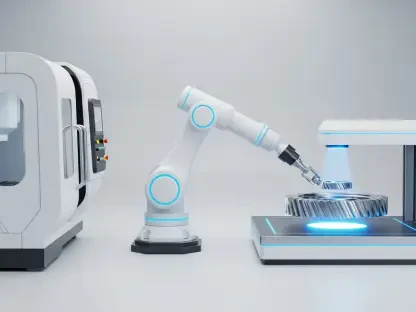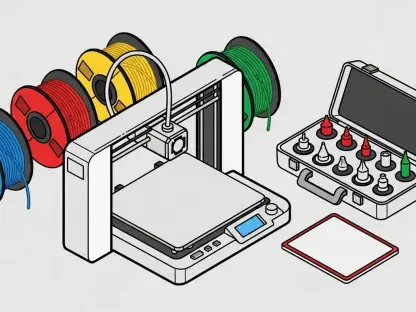The manufacturing sector is undergoing a significant transformation, thanks to the confluence of Artificial Intelligence (AI) and the Internet of Things (IoT). These advanced technologies are key drivers of Industry 4.0, enabling businesses to enhance operational efficiency and stay competitive in the global market. This article explores how AI and IoT are revolutionizing predictive maintenance in manufacturing, providing deeper insights through a well-structured and engaging narrative.
The Evolution of Predictive Maintenance
Understanding Predictive Maintenance
Predictive maintenance leverages data analytics to foresee potential machine failures, allowing manufacturers to schedule proactive servicing before major issues arise. This innovative approach moves away from traditional maintenance methods, which are typically based on fixed schedules and often lead to either unnecessary downtime or unexpected equipment breakdowns. Through machine learning, AI can process vast volumes of data gathered from sensors and IoT devices installed in machinery, identifying patterns, detecting anomalies, and predicting potential failures with remarkable precision.
By analyzing data on metrics such as temperature, vibration, and pressure levels in real-time, AI helps manufacturers anticipate when a machine might require maintenance. This advanced capability significantly reduces the likelihood of unexpected equipment failures, ensuring that machinery remains operational for longer periods. Furthermore, the continuous monitoring aspect of predictive maintenance allows for the early detection of issues that could evolve into more significant problems if left unaddressed. This proactive approach minimizes disruptions and maximizes production efficiency within the manufacturing environment.
The Role of Data
The backbone of predictive maintenance is data, sourced through numerous IoT devices embedded in machinery that capture real-time metrics. These metrics include a wide array of data points, such as temperature, vibrations, pressure levels, and other operational parameters vital to the performance and health of the equipment. AI’s sophisticated algorithms then process this data, transforming an ocean of raw information into actionable insights that can guide maintenance efforts. This relationship between AI and IoT creates a self-improving system, one that continuously refines its predictive capabilities as more data flows in, enhancing its accuracy and reliability over time.
The immense volume of data collected and processed empowers predictive maintenance systems to identify subtle changes and anomalies that human operators might overlook. This capacity to detect early warning signs ensures that potential problems are addressed before they escalate into major failures, thus maintaining a smooth operational flow. Besides improving prediction accuracy, this synergy between AI and IoT also facilitates better decision-making and strategic planning, as manufacturers can base their maintenance schedules and resource allocation on precise, data-driven insights rather than on estimations or historical trends.
Real-World Applications
Case Studies in Action
Several leading companies have harnessed the power of AI-driven predictive maintenance to optimize their operations and reduce expenses. Siemens, a global powerhouse in industrial manufacturing, employs AI technologies to streamline processes, enhance plant efficiency, and reduce costly and time-consuming repairs. Similarly, Rockwell Automation’s FactoryTalk Analytics GuardianAI uses advanced analytics to provide real-time insights that prevent unplanned downtime, while Nokia’s AI-based maintenance systems are known for their ability to optimize equipment performance and extend machinery life.
These practical applications of AI-driven predictive maintenance illustrate its tangible benefits, such as significant reductions in unplanned downtime and impressive cost savings. For example, Siemens’ deployment of AI technologies in its plants has resulted in smoother operations and a substantial decrease in maintenance-related costs. By accurately predicting when and where equipment is likely to fail, these companies can carry out maintenance during non-critical periods, ensuring that production lines remain uninterrupted. This level of foresight and precision in maintenance planning enhances both productivity and profitability, showcasing the real-world value of AI and IoT innovations in industrial settings.
Measuring the Impact
The impact of predictive maintenance on the manufacturing sector is both profound and measurable, with considerable benefits reported across various industries. Studies indicate that predictive maintenance can reduce unscheduled downtime by as much as 40%, which translates to significant operational cost savings. By preemptively addressing minor issues before they escalate into major problems, companies can avoid the financial burden of emergency repairs, minimizing the need for expensive spare parts and storage. This not only improves cost efficiency but also enhances overall resource allocation.
Moreover, the regular maintenance facilitated by predictive algorithms prolongs the lifespan of machinery, ensuring a higher return on investment. Well-maintained equipment tends to operate more efficiently and with lower risk of malfunctions, which is crucial for maintaining high safety standards in industries like automotive manufacturing and heavy machinery. Enhanced safety leads to fewer workplace accidents and improved job satisfaction among employees. Additionally, by maintaining equipment in optimal condition, manufacturers can ensure better product quality and greater customer satisfaction, providing a competitive edge in the marketplace.
Key Advantages
Reduced Downtime and Cost Efficiency
One of the most significant advantages of AI-driven predictive maintenance is its ability to reduce downtime, thereby enhancing production continuity. By identifying potential issues before they become critical, manufacturers can schedule maintenance during less disruptive periods, such as off-peak hours or planned downtimes. This strategic planning minimizes interruptions to production processes and ensures a smoother and more efficient workflow. The reduction in unscheduled maintenance translates to fewer financial losses associated with halted production, improving the bottom line for manufacturers.
Cost efficiency is another critical benefit, as predictive maintenance reduces the need for emergency repairs, which are often more expensive than planned maintenance activities. Additionally, by accurately forecasting maintenance needs, companies can minimize the necessity of holding large inventories of spare parts, which require storage space and management resources. This streamlined approach to parts inventory management leads to significant cost savings and better utilization of warehouse space. Overall, the financial gains from reduced downtime and lower maintenance costs make predictive maintenance an attractive investment for manufacturers aiming to enhance their operational efficiency.
Enhanced Equipment Longevity and Safety
Routine maintenance that proactively addresses minor equipment issues helps extend the life of machinery, which is a vital component of maximizing return on investment. By identifying and rectifying small problems before they cause significant damage, predictive maintenance ensures that machinery operates at optimal levels for longer periods. This increased equipment longevity reduces the frequency of costly replacements and boosts the overall productivity of manufacturing plants. Well-maintained machinery is not only more reliable but also contributes to consistent production quality, which is crucial for maintaining customer satisfaction and brand reputation.
Equally important is the enhancement in workplace safety resulting from predictive maintenance. Regularly serviced equipment is less likely to malfunction, significantly reducing the risk of accidents and ensuring a safer working environment for employees. This is particularly critical in industries with stringent safety requirements, such as automotive manufacturing and heavy machinery operations, where equipment failures can have severe consequences. By investing in predictive maintenance, companies can demonstrate their commitment to worker safety and regulatory compliance, fostering a culture of safety and responsibility within their organizations.
Emerging Trends and Future Directions
Edge AI for Faster Decisions
Edge AI, which involves processing data near its source rather than relying on cloud-based servers, is a cutting-edge trend that enhances the efficiency of predictive maintenance. By minimizing delays associated with data transmission and processing, edge AI enables quicker decision-making and more responsive maintenance actions. This trend is becoming increasingly popular as manufacturers seek faster, more reliable systems that can preemptively address issues with minimal latency. By reducing the time it takes to detect and respond to potential problems, edge AI ensures that machinery operates with maximum efficiency and minimal disruption.
The deployment of edge AI systems in manufacturing environments allows for real-time data analysis and immediate action, further improving operational efficiency. This capability is particularly beneficial in high-speed production lines where even brief delays can lead to significant losses. By processing data on-site, edge AI reduces dependency on centralized data centers, enhancing data security and lowering the risks associated with data breaches. As businesses continue to adopt edge AI, the ability to make swift, informed decisions will become an integral component of predictive maintenance strategies, driving further advancements in manufacturing efficiency.
Digital Twins and Advanced Machine Learning
Another emerging trend in predictive maintenance is the creation and utilization of digital twins—virtual replicas of physical assets. Digital twins allow manufacturers to simulate various scenarios and test the impact of different maintenance strategies without affecting actual operations. This innovative approach provides valuable insights into equipment performance, enabling more accurate predictions of maintenance needs and optimizing operational efficiency. As digital twins become more prevalent, they will serve as powerful tools for manufacturers to enhance their maintenance planning and execution processes.
Simultaneously, advanced machine learning models are constantly evolving, further improving the reliability and precision of predictive maintenance systems. These AI models are capable of analyzing complex data sets and identifying intricate patterns that traditional methods might overlook. By incorporating advanced machine learning techniques, predictive maintenance systems can better anticipate equipment failures and recommend more effective maintenance actions. This continuous improvement in AI capabilities ensures that predictive maintenance remains at the forefront of industrial innovation, driving greater reliability and efficiency in manufacturing processes.
Challenges to Implementation
Data Security and Initial Costs
Despite the clear benefits, the implementation of AI and IoT in predictive maintenance presents several challenges that manufacturers must address. One of the primary concerns is data security, as increased connectivity and the proliferation of IoT devices create potential vulnerabilities. Ensuring the protection of sensitive data from cyber threats and unauthorized access requires robust security measures and constant vigilance. Additionally, integrating advanced AI and IoT technologies into existing systems often involves substantial initial costs, which can be a barrier for some companies, especially smaller enterprises with limited budgets.
The high upfront investment includes the costs of purchasing and installing IoT sensors, deploying AI software, and training staff to manage and operate these advanced systems. While the long-term benefits of predictive maintenance can outweigh these initial expenditures, companies must carefully consider their financial planning and resources before undertaking such initiatives. Developing a comprehensive implementation strategy that accounts for potential challenges and allocates sufficient resources for security and training is crucial for the successful adoption of predictive maintenance technologies.
Workforce Readiness
The manufacturing sector is experiencing a profound transformation driven by the integration of Artificial Intelligence (AI) and the Internet of Things (IoT). These cutting-edge technologies are the backbone of Industry 4.0, allowing companies to boost operational efficiency and maintain a competitive edge in the global marketplace. This shift is particularly evident in the realm of predictive maintenance, where AI and IoT come together to revolutionize manufacturing processes. Predictive maintenance leverages these technologies to foresee potential equipment failures before they occur, significantly reducing unplanned downtime and lowering maintenance costs. By collecting real-time data from IoT sensors and analyzing it with AI algorithms, manufacturers can gain valuable insights into equipment performance and health. This anticipatory approach not only ensures continuous production but also extends the lifespan of machinery. The blending of AI and IoT offers an engaging and structured narrative on how today’s factories are being smartly managed, contributing to a more efficient and resilient manufacturing landscape.









